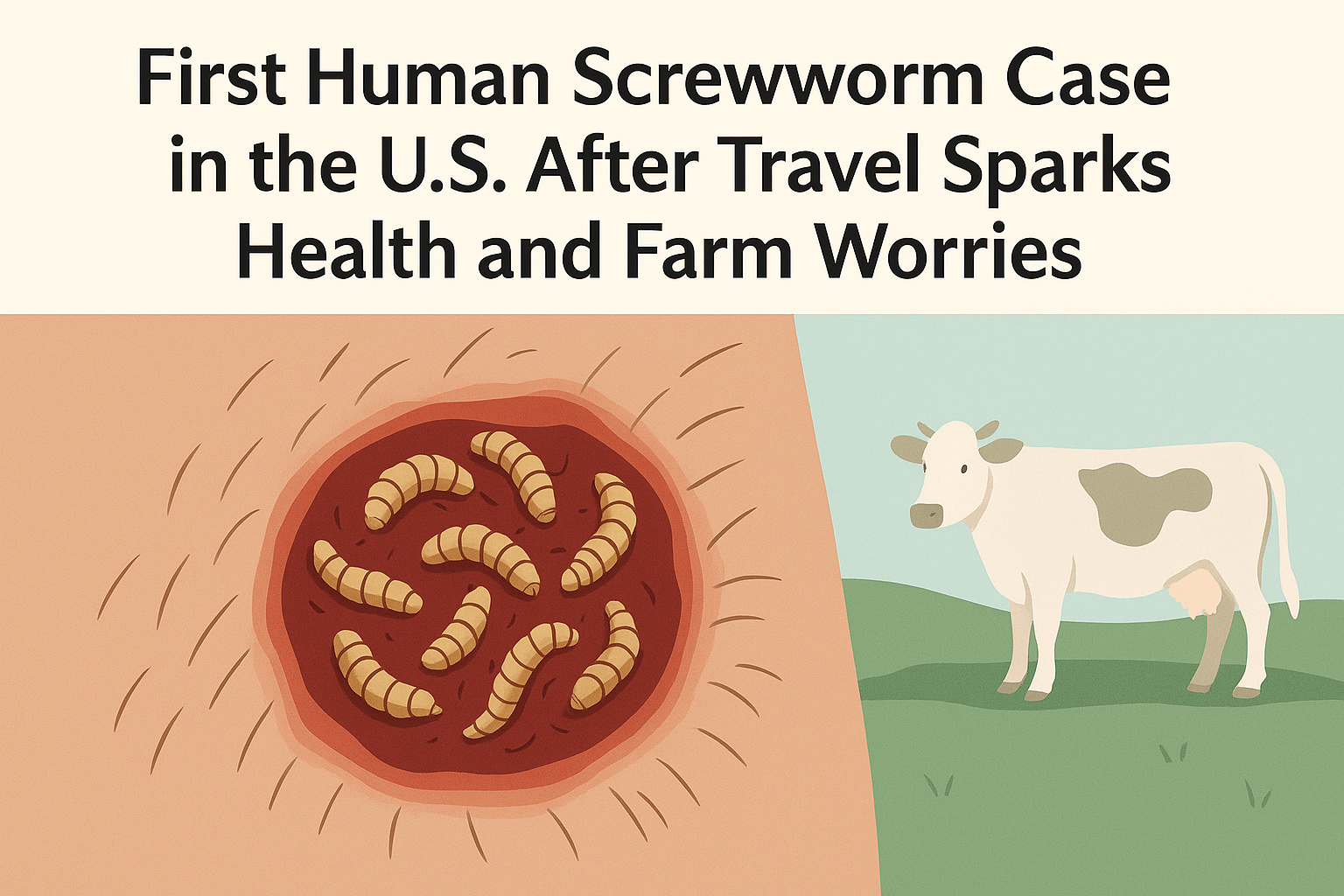When news broke that a person in the United States was confirmed to have a screwworm infection after traveling from Central America, many people became curious, while others felt worried. It has been decades since America last dealt with this parasite in humans, and the announcement quickly turned into a hot topic across health and farming circles.
The case was confirmed in early August 2025, when a person who had recently traveled from El Salvador to the U.S. was found to be carrying the flesh-eating parasite. The diagnosis was made by the Centers for Disease Control and Prevention after tests showed the presence of screwworm larvae. Health officials explained that the risk to the general public is still very low, but even with that assurance, the discovery sent waves of concern, especially in the farming and livestock industry.
The screwworm is not just any parasite. For farmers, this insect represents fear and heavy loss. The female screwworm fly lays her eggs in open wounds of warm-blooded animals, and when the larvae hatch, they begin to feed on flesh. If this happens and treatment is delayed, the animal can die. For people, the effect is painful, dangerous, and shocking because the worm literally eats living tissue. This makes the parasite one of the most feared threats in agriculture and human health history.
ALSO READ: Interesting stories
For many years, the U.S. had lived free from screwworm worries. The last big fight against the parasite happened decades ago, and the battle was won using a unique method. Scientists used what they called the sterile insect technique. They raised millions of male flies, sterilized them, and then released them into the wild. These sterile males would mate with females, but no eggs would hatch. Slowly, the population of screwworms dropped until they were completely wiped out of the U.S. by 1982. It was considered one of the greatest victories in pest control. In 2016, there was a smaller outbreak in Florida affecting wild deer, but it was quickly contained by 2017. Since then, the country has stayed safe—until now.
LEARN MORE ABOUT THIS PRODUCT!!!
That is why the new case confirmed in August 2025 brought back old fears. While health officials say the infection was connected only to travel and does not mean screwworms are spreading in the U.S., the thought of the parasite returning is something no one wants to imagine. Farmers are especially alert because they know what is at stake. If screwworms were to re-establish in American soil, the economic damage could be massive. Experts say Texas alone could lose more than 1.8 billion dollars if the pest spreads unchecked. This figure comes from the cost of treating livestock, the death of animals, and the labor needed to fight the outbreak.
Because of this risk, the U.S. Department of Agriculture quickly set plans in motion. One of the biggest steps is the decision to build a sterile fly production facility in Texas. The goal is to prepare for any possible outbreak by being able to release sterile insects again, the same method that saved the country decades ago. At the same time, the U.S. stopped imports of Mexican cattle through southern ports as a protective measure. By cutting off possible entry points for the parasite, authorities hope to block the screwworm before it has a chance to spread.
LEARN MORE: Read blogs and articles here!!!
Even though the confirmed case was only one person, and that person had traveled from a country where an outbreak is happening, the seriousness of screwworms makes officials treat it as a red alert. Central America has been dealing with growing cases, and travelers from the region can unknowingly bring larvae with them. In the recent case, the infection was discovered and treated, but it serves as a warning.
For the average person, the chances of getting infected are very slim. Screwworms do not spread from one person to another like a flu virus. Instead, they target wounds. If someone travels from an outbreak zone with an untreated wound, that is where the risk lies. Doctors have reassured people that the infection can be treated once discovered, usually by removing the larvae and using medicine to heal the wound. Still, the fear factor is high because of the disturbing nature of the parasite. Nobody wants to hear the words “flesh-eating worm” linked to humans.
Looking at history, the screwworm story shows how fragile victories over parasites can be. For decades, America lived free from this pest, but a single travel-related case has brought it back into headlines. It shows how connected the world is today. A person can board a plane in one country and arrive in another within hours, sometimes carrying more than just luggage. This is why health surveillance and fast response are critical.
LEARN MORE ABOUT THIS PRODUCT!!!
The U.S. has also been reminding travelers to take precautions. People going to or coming from areas with outbreaks are advised to care for wounds properly, avoid exposure to flies, and report any unusual symptoms after returning. Livestock importers are under strict watch, as animals remain the biggest concern in preventing the return of screwworm to American farms.
For farmers who still remember the dark days of battling screwworms, the news feels like déjà vu. Many recall how entire herds of cattle were once threatened by the parasite, and the relief when the U.S. was declared screwworm-free in 1982 was unforgettable. To think that this parasite might return is frightening, but the government’s quick response brings some comfort.
ALSO CHECK: Affordable products
What makes the screwworm such a tough enemy is its ability to spread silently. Female flies can travel long distances to find wounds, and once larvae hatch, they dig deep into flesh. Without treatment, the results are devastating. This is why the sterile insect technique was so effective before, because it targeted the life cycle itself and broke the chain. Experts believe that being prepared with the same method today is the strongest defense America can have.
The case also highlights another truth: parasites and diseases do not respect borders. As long as outbreaks exist in other countries, there will always be a risk of them reaching new places. This is why cooperation across borders is important. Central American countries, along with the U.S., will need to work hand in hand to control screwworms and stop them from spreading further north.
For ordinary people hearing the news, the main message is not to panic but to stay informed. The government has made it clear that there is no widespread danger, and the infection was caught early. But it is also a reminder that health threats can return when least expected. A parasite thought to be gone decades ago has managed to appear again, showing that constant vigilance is the price of safety.
Start Trading Your Crypto with Bybit Now!!!
The future will depend on how quickly measures are enforced and how strongly the U.S. maintains surveillance. With a new sterile fly facility, stricter livestock controls, and public awareness, the chances of screwworm making a permanent comeback remain slim. Still, the incident is a wake-up call.
LEARN MORE ABOUT THIS PRODUCT!!!
The fight against screwworm in America is not fully over. The latest case proves that while history showed victory, nature can always surprise us. As people continue to travel around the world, and as climate change shifts the environment, parasites that once seemed gone can find new opportunities to return. This is why preparedness is not just an option—it is a necessity.
So while health officials calm the public that the risk is low, they are not taking chances. Farmers, ranchers, and veterinarians are staying alert. And the memory of what screwworms once did to livestock and even humans remains sharp enough to remind everyone why one case is more than enough reason to act fast.




